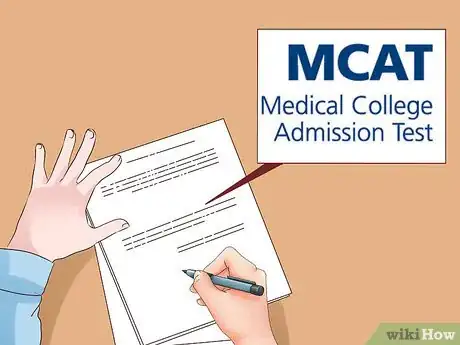This article was medically reviewed by Jonas DeMuro, MD. Dr. DeMuro is a board certified Pediatric Critical Care Surgeon in New York. He received his MD from Stony Brook University School of Medicine in 1996. He completed his fellowship in Surgical Critical Care at North Shore-Long Island Jewish Health System and was a previous American College of Surgeons (ACS) Fellow.
There are 15 references cited in this article, which can be found at the bottom of the page.
wikiHow marks an article as reader-approved once it receives enough positive feedback. In this case, 95% of readers who voted found the article helpful, earning it our reader-approved status.
This article has been viewed 135,072 times.
The road to becoming a neurosurgeon requires hard work but has huge rewards. Not only do neurosurgeons get to improve the lives of their patients, but they also make a very good living — base salaries for a neurosurgeon in their first year is around $350,000 with top surgeons making over $900,000.[1] Neurosurgeons specialize in the surgical treatment of nervous system disorders. The nervous system carries messages to and from the brain and body.[2] If you are interested in becoming a brain surgeon, you will need to develop some skill sets, prepare for and attend medical school, plus do six to eight years of residency to practice as a neurosurgeon.
Steps
Developing Skill Sets
-
1Practice cultivating patience, understanding and empathy early. These are qualities that allow neurosurgeons to communicate with, diagnose and treat patients who may be in distress or pain. They may work with people who are unable to communicate effectively or have special needs.[3]
- Meet new people, find things you have in common and try to understand your differences. Put yourself in other people's shoes to understand what a person is feeling or why he chose certain actions.[4]
- Challenge prejudices. We often have preconceived notions about groups of people. Focus on what you share with individuals instead of what divides you. [5]
- Listen to people. The ability to focus on another person’s emotional state and needs is an important skill for a neurosurgeon to have. Paraphrase what people say to you to show that you are an active listener and ensure you understand what they are saying. [6]
- Consider learning another language. This is an extremely valuable skill. You will often encounter people who speak a different language. Speaking another (or multiple) language can help you easily communicate with these patients and can help you stand out when applying to med school.[7]
-
2Practice professionalism. Learn to work well within a team and take on leadership roles. Physicians understand ethical principles and moral reasoning. They must make decisions about patient care and implement treatment plans.Advertisement
-
3Use critical-thinking and problem-solving skills regularly. Learn how to collect information and research problems to find solutions. Explore areas you are unfamiliar with and use trusted sources of information to gain new knowledge.
-
4Build 3D models and put together puzzles. Neurosurgeons operate in and around the brain so they need to be able to understand spatial relationships and use their hands with skill. Visualize how things go together. Put together complex models with your hands. Learn how to collect information and research problems to find solutions. [8]
- You will also need to be skilled and dexterous with your hands, as neurosurgery is delicate work. However, don't stress over this too much, as much of your manual dexterity will be acquired through experience. [9]
Preparing for Medical School
-
1Take advanced science, biology, anatomy and physics classes in high school. Colleges look for students who can succeed in challenging and rigorous courses. These classes will also help you succeed in the demanding college courses required to get into medical school.
-
2Volunteer at hospitals, clinics and nursing homes as early as you can. Familiarize yourself with the way healthcare settings function, such as how physicians and staff interact. Watch how patients are treated and what physicians do. Shadow a doctor, preferably a neurologist or neurosurgeon if you can.
-
3Go to an accredited college and earn your bachelor's degree. Make sure to take courses that satisfy pre-medical school requirements. Many successful medical students major in biology but it is not a requirement for admission to medical school. Consider a major in neurobiology or neuroscience if these are offered.
- Your degree should include a core curriculum that consists of chemistry, organic chemistry, biology, calculus and physics courses with labs.
- Taking biochemistry, microbiology and human anatomy classes will increase your chances of getting into medical school and doing well there.
- A few medical schools offer combined undergraduate and medical school programs that last six or seven years. If this interests you, look into these programs.
-
4Study and get good grades. Medical school is very competitive. Strive for at least a 3.0 GPA, though a 3.5 or above is better. [10]
- Your first-year biology grades are especially important. Some schools will disqualify students with Cs and lower. Try to earn at least a 3.75 GPA your freshman year of college.[11]
- Spend time studying throughout the week to review material covered in class. Join a study group and go over important information with friends. Purchase, borrow or rent course reviews and quizzes. If you need help, get a tutor through your college or hire an independent instructor.
- The higher you can get your grades, the better you will look to admissions committees. This will give you the best chance of getting into the college you want. GPA is also important to qualify for scholarships that will pay for college.
-
5Do undergraduate research. This is another way to set yourself apart from other applicants. Participating in undergraduate research indicates that you are a curious and hardworking, and it may help you get additional recommendations and advocates from your mentors. Ask your professors if they are working on any research projects to which you might contribute, or if they have any colleagues that you could work with. In addition, look into research opportunities for undergraduates at medical clinics (such as the Cleveland Clinic). [12]
-
6Seek recommendations. You will need to submit letters of recommendations to get into medical school from professors or employers who are familiar with you and your work. Take on a research or teaching assistant position and take this opportunity to build a relationship with faculty members.
Applying to Med School
-
1Plan to take the MCAT (Medical College Admissions Test). This is a standardized examination required by all US medical schools and many in Canada. This test score is one of the most important factors for medical school admission. Give yourself adequate time to prepare for it.
- Many students take the MCAT during their junior year after studying for several months, while others prefer to finish four years of college before taking the MCAT. You might decide to take the test sooner if you have taken some advanced placement coursework or classes during the summer.[13]
- The MCAT tests foundational concepts, scientific inquiry, critical analysis and reasoning skills drawn from biology, biochemistry, organic chemistry, general chemistry, physics, psychology and sociology. Do your best to be familiar with these disciplines and practice your reading analysis skills.
-
2Register to take the MCAT. The Association of American Medical Colleges (AAMC) administers the MCAT throughout the year at hundreds of test sites throughout the US and Canada, along with other locations. Check with the AAMC for test dates and locations near you.[14]
- Register early, at least 60 days in advance of the exam date, to get your preferred test date or location. You must pre-register online and pay a fee.
- Enter your information into the Scheduling and Registration System exactly as it appears on your identification (ID) and make sure your contact information is correct.
- If you are unable to pay for the MCAT exam, you may be eligible for the Fee Assistance Program (FAP). You will need to submit an application and be approved before you register for the MCAT.
-
3Take the MCAT. Arrive at least 30 minutes early with a government-issued ID. You can only bring yourself, your clothes and a watch into the test room. Lockers and locks are usually offered for your other personal items, such as a cell phone. [15]
- Study hard before the test. Aim for a score of 32 or higher.[16] Buy or rent an MCAT prep book or take a review course. You may also sign up for practice exams that prepare you for the real thing.[17]
- If you don’t get the score you want, you can retake the MCAT up to three times a year and seven times during your lifetime. Keep in mind, though, that different schools will treat multiple scores differently—some may average them while others may take the most recent or best score.[18]
-
4Choose several accredited medical schools with strong neurosurgery programs to apply to. Medical schools can be very different and you will need to research each school to find the best medical schools for you. Factors to consider include location, cost, curriculum, facilities, financial aid, residency placement and reputation.
-
5Apply to several accredited medical schools at the same time. This will increase your chances of getting accepted. If you select schools that take part in the Early Decision Program (EDP), then you may secure an acceptance early and still have time to apply to other schools if you are not accepted. [19]
- Applicants usually submit transcripts, MCAT scores and letters of recommendation but schools may also consider personality, leadership qualities and participation in extracurricular activities. Most schools will require interviews with admissions committee members.
- You will apply through the American Medical College Application Service (AMCAS) and/or the American Association of Colleges of Osteopathic Medicine Application Service (AACOMAS) and the services will send your application to your desired schools. US medical schools that confer the Doctor of Medicine (M.D.) degree use AMCAS as the primary application method for students whereas osteopathic medical schools that confer the Doctor of Osteopathic Medicine (D.O.) degree use AACOMAS.
- In the case of rejection, don’t give up. Not everyone gets into the medical school of choice but with hard work and dedication you will get into a medical school.
- Most applicants to medical school have at least a bachelor's degree, but many have advanced degrees as well. If you have difficulty getting into medical school consider getting a master’s degree or higher before applying again.
- If you are selected to interview, study up on the school so you will be able to ask relevant questions. You may want to practice your interviewing skills before you meet with the school. A good impression will give you a good chance at being offered a position with the school.
Earning Your M.D.
-
1Take all required courses for the M.D. or D.O. degree You will attend medical school for four years. This time will be spent in laboratories and classrooms as well as gaining practical skills, such as taking medical histories and diagnosing patients under the supervision of experienced physicians.
- Identify a resident and faculty mentor in neurosurgery as soon as possible. These mentors can help you put together your residency application and expose you to operating room and neurosurgery clinics.
- Enrolling in an elective during medical school can help you decide if being a neurosurgeon is right for you. If you are interested in neurosurgery, you should do sub-internships during the fourth year of medical school.
- You can also gain neurosurgery exposure by attending the weekly didactic sessions and grand rounds at your school’s neurosurgery residency program. You can learn more about neurosurgery and interact with faculty and residents at these sessions.
-
2Get good grades. You want to do well in medical school and make connections to get a good internship and residency placement later on. You will want to cultivate relationships and earn letters of recommendation.
-
3Participate in research projects. You should gain experience with research, preferably in the neuroscience and neurosurgical fields. Research participation will help you get to know faculty members, contribute to exciting advances in medicine and increase your chances of getting into the residency of your choice.
- Look into faculty members credentials, interests and the research they are involved in. Talk to them about potential openings for students to participate. Let them know you are interested and find out what you need to do to apply.
- Publishing in a peer-reviewed journal about your research will look excellent on your application to residency programs.
- The summer after your first year of medical school may be an optimal time to begin researching and shadowing at this level.
- You can also attend national conferences like the annual meeting of the American Association of Neurological Surgeons to make connections with residents and neurosurgeons from around the world.
Becoming a Neurosurgeon
-
1Match into a residency program. Toward the end of medical school, medical students interested in a career in neurosurgery will apply through the Neurosurgery Match Program. The program pairs applicants and neurosurgical programs.
- There are around 100 neurosurgical residency programs in the US and each accepts about one to three residents. You will need to apply to more than one residency program to ensure that you get in, though odds are very good for candidates in neurosurgery.[20]
- Plan for alternatives. Matching a residency in neurosurgery is extremely competitive, and there is a possibility you will not match. Ask yourself what you will do in this event. How can you improve your application? What can you do in the year before you can reapply — research, an internship, or something else? You may wish to consider applying for a general surgical position while also applying to neurosurgery positions. Talk to your advisors about what you might do to prepare for this possibility.
-
2Do your internship. Usually, you will do your internship at the same place as your neurosurgery residency program. This is your first year as a doctor, and you will learn how to manage patients, learn procedures, management decisions and basic operative techniques.
-
3Spend six to eight years in a neurosurgery residency. During this time, you will spend the first two years as a junior resident managing ICU patients, doing consultations and basic to more complicated operations. As a mid-level resident, you may do a rotation at a children’s hospital, elective time or research. Afterward, you will do one to two years of research or a fellowship in a sub-specialty before doing one year as chief resident with increasing responsibilities and performing complex operations.
-
4Take the ABNS certification exam. At the conclusion of your residency, you will study for and pass the certification examination administered by the American Board of Neurological Surgery (ABNS). Most states require physicians to have this certification to get a license. There may also be other state requirements, so check with your state.
-
5Apply for a license. In the US, surgeons must pass a standardized national licensure examination. M.D.s take the U.S. Medical Licensing Examination (USMLE) and DOs take the Comprehensive Osteopathic Medical Licensing Examination (COMLEX). By gaining licensure, you can practice as a neurosurgeon. [21]
- Candidates must graduate from an accredited medical school, complete one year of residency training in their specialty and pass written and practical exams in order to qualify for a license.
-
6Complete a fellowship. You may want to specialize in a particular area of neurosurgery after residency. These include pediatric, spinal, vascular/endovascular, tumor, peripheral nerve, functional or skull base. To do this, you must undertake a fellowship under the supervision of a qualified specialist and then obtain state certification.
-
7Set up your own business or get employed by a hospital. Apply for open neurosurgeon positions at the hospital or clinic of your choice. Consult with relevant attorneys and business advisors about opening your practice.
- To open your own practice, first secure financing and a location. You may get loans through local or commercial banks. You could also try a lending company as well as philanthropists or those looking for an investment opportunity. Look for a suitable office space that is accessible. [22]
- Procure computers, software and medical equipment to help your practice run smoothly.
- You will need to hire staff members, such as other physicians, nurses, medical assistants, office managers and administrative assistants.
- Get credentialed with major insurance companies to begin accepting new patients. This process with the health insurance companies can take several months. [23]
- Find medical malpractice insurance. Look for reasonable rates and coverage.
- Bring in patients through advertisements, online reviews, word of mouth, etc. and start practicing.
-
8Keep up with continuing education requirements. This may include annual meetings, conferences, scientific journals and research. You need to be up to date with rapidly advancing neurosurgeon research and technology.
Warning
- Many surgeons work long, irregular, and overnight hours. They may travel between offices and hospitals. While on call, a physician may need to speak to a patient over the phone or make an emergency visit.
- Earnings can vary with the neurosurgeon’s experience, geographic region of practice, hours worked, skill, personality and professional reputation.
References
- ↑ http://www.alliedphysicians.com/salary-surveys/physicians/
- ↑ https://www.urmc.rochester.edu/highland/departments-centers/neurosurgery/what-is-a-neurosurgeon.aspx
- ↑ http://www.med.nyu.edu/neurosurgery/education-training/how-do-i-become-neurosurgeon
- ↑ http://greatergood.berkeley.edu/article/item/six_habits_of_highly_empathic_people1
- ↑ http://greatergood.berkeley.edu/article/item/six_habits_of_highly_empathic_people1
- ↑ http://greatergood.berkeley.edu/article/item/six_habits_of_highly_empathic_people1
- ↑ http://study.com/articles/How_to_Become_a_Neurosurgeon_Education_and_Career_Roadmap.html
- ↑ http://www.med.nyu.edu/neurosurgery/education-training/how-do-i-become-neurosurgeon
- ↑ http://www.med.nyu.edu/neurosurgery/education-training/how-do-i-become-neurosurgeon
- ↑ http://www.huffingtonpost.com/scott-willyerd/want-to-go-to-medical-sch_b_5111062.html
- ↑ http://www.huffingtonpost.com/scott-willyerd/want-to-go-to-medical-sch_b_5111062.html
- ↑ https://www.usnews.com/education/blogs/medical-school-admissions-doctor/2014/02/18/elevate-medical-school-applications-with-research-experience
- ↑ http://www.huffingtonpost.com/scott-willyerd/want-to-go-to-medical-sch_b_5111062.html
- ↑ https://www.aamc.org/students/applying/
- ↑ http://www.mommd.com/inquarta05.shtml
- ↑ http://www.huffingtonpost.com/scott-willyerd/want-to-go-to-medical-sch_b_5111062.html>
- ↑ https://students-residents.aamc.org/applying-medical-school/taking-mcat-exam/prepare-mcat-exam/
- ↑ https://www.aamc.org/students/download/63060/data/mcatessentials.pdf
- ↑ https://www.aamc.org/students/applying/requirements/edp/
- ↑ http://www.med.nyu.edu/neurosurgery/education-training/how-do-i-become-neurosurgeon
- ↑ http://www.usmle.org/apply/index.html
- ↑ http://www.mommd.com/bcstartpractc.shtml
- ↑ http://www.mommd.com/bcstartpractc.shtml
About This Article
To become a neurosurgeon, go to an accredited 4-year college and take courses like chemistry, organic chemistry, and biology to satisfy pre-medical school requirements and earn a bachelor's degree. Next, study for and take the MCAT, which is required for medical school admission, and enroll in an accredited medical school. When you're nearing graduation, match into a residency program and complete 6-8 years of residency. Then, take the ABNS certification exam and apply for your medical license to start practicing! For tips on matching into a residency program, read on!
-Step-3-Version-2.webp)























































































